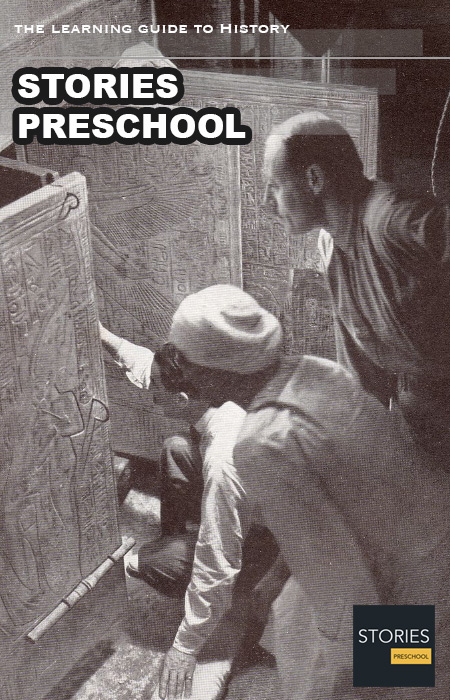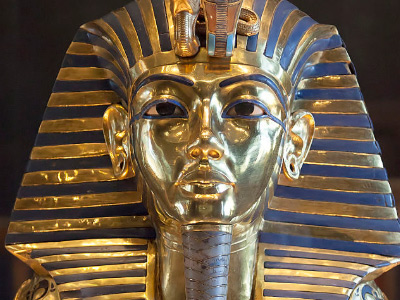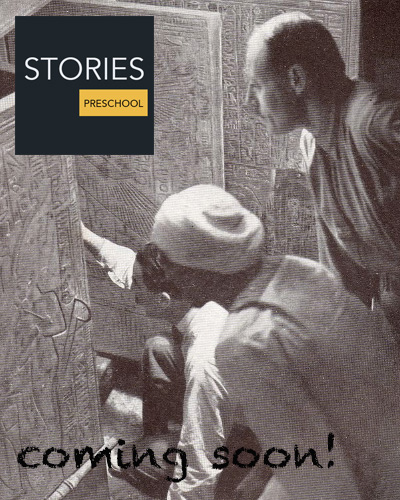King Tut (1341-1323 BC)
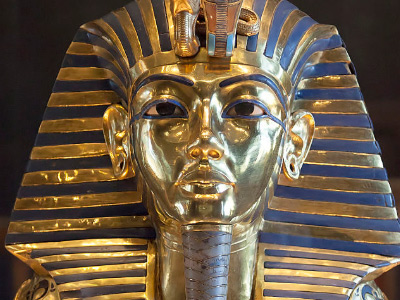
Tutankhamun was an Egyptian pharaoh of the 18th dynasty (ruled c. 1332–1323 BC in the conventional chronology), during the period of Egyptian history known as the New Kingdom or sometimes the New Empire Period. He has, since the discovery of his intact tomb, been referred to colloquially as King Tut. His original name, Tutankhaten, means "Living Image of Aten", while Tutankhamun means "Living Image of Amun". In hieroglyphs, the name Tutankhamun was typically written Amen-tut-ankh, because of a scribal custom that placed a divine name at the beginning of a phrase to show appropriate reverence. He is possibly also the Nibhurrereya of the Amarna letters, and likely the 18th dynasty king Rathotis who, according to Manetho, an ancient historian, had reigned for nine years—a figure that conforms with Flavius Josephus's version of Manetho's Epitome.
The 1922 discovery by Howard Carter of Tutankhamun's nearly intact tomb, funded by Lord Carnarvon, received worldwide press coverage. It sparked a renewed public interest in ancient Egypt, for which Tutankhamun's mask, now in the Egyptian Museum, remains the popular symbol. Exhibits of artifacts from his tomb have toured the world. In February 2010, the results of DNA tests confirmed that he was the son of the mummy found in the tomb KV55, believed by some to be Akhenaten. His mother was his father's sister and wife, whose name is unknown but whose remains are positively identified as "The Younger Lady" mummy found in KV35. The "mysterious" deaths of a few of those who excavated Tutankhamun's tomb has been popularly attributed to the curse of the pharaohs.
Life
Tutankhamun was the son of Akhenaten (formerly Amenhotep IV) and one of Akhenaten's sisters, or possibly one of his cousins. As a prince, he was known as Tutankhaten. He ascended to the throne in 1333 BC, at the age of nine or ten, taking the throne name Nebkheperure. His wet nurse was a woman called Maia, known from her tomb at Saqqara. His teacher was most likely Sennedjem.
When he became king, he married his half-sister, Ankhesenpaaten, who later changed her name to Ankhesenamun. They had two daughters, both stillborn. Computed tomography studies released in 2011 revealed that one daughter was born prematurely at 5–6 months of pregnancy and the other at full-term, 9 months. No evidence was found in either mummy of congenital anomalies or an apparent cause of death.
Reign
Given his age, the king probably had very powerful advisers, presumably including General Horemheb (Grand Vizier Ay's possible son in law and successor) and Grand Vizier Ay (who succeeded Tutankhamun). Horemheb records that the king appointed him "lord of the land" as hereditary prince to maintain law. He also noted his ability to calm the young king when his temper flared.
In his third regnal year, under the influence of his advisors, Tutankhamun reversed several changes made during his father's reign. He ended the worship of the god Aten and restored the god Amun to supremacy. The ban on the cult of Amun was lifted and traditional privileges were restored to its priesthood. The capital was moved back to Thebes and the city of Akhetaten abandoned. This is when he changed his name to Tutankhamun, "Living image of Amun", reinforcing the restoration of Amun.
As part of his restoration, the king initiated building projects, in particular at Karnak in Thebes, where he dedicated a temple to Amun. Many monuments were erected, and an inscription on his tomb door declares the king had "spent his life in fashioning the images of the gods". The traditional festivals were now celebrated again, including those related to the Apis Bull, Horemakhet, and Opet. His restoration stela says:
The temples of the gods and goddesses ... were in ruins. Their shrines were deserted and overgrown. Their sanctuaries were as non-existent and their courts were used as roads ... the gods turned their backs upon this land ... If anyone made a prayer to a god for advice he would never respond.
The country was economically weak and in turmoil following the reign of Akhenaten. Diplomatic relations with other kingdoms had been neglected, and Tutankhamun sought to restore them, in particular with the Mitanni. Evidence of his success is suggested by the gifts from various countries found in his tomb. Despite his efforts for improved relations, battles with Nubians and Asiatics were recorded in his mortuary temple at Thebes. His tomb contained body armor and folding stools appropriate for military campaigns. However, given his youth and physical disabilities, which seemed to require the use of a cane in order to walk (he died c. age 19), historians speculate that he did not personally take part in these battles.
Aftermath
With the death of Tutankhamun and the two stillborn children buried with him, the Thutmoside family line came to an end. The Amarna letters indicate that Tutankhamun's wife, recently widowed, wrote to the Hittite king Suppiluliuma I, asking if she could marry one of his sons. The letters do not say how Tutankhamun died. In the message, Ankhesenamun says that she was very afraid, but would not take one of her own people as husband. However, the son was killed before reaching his new wife. Shortly afterward, Ay married Tutankhamun's widow and became Pharaoh as a war was fought between the two countries, and Egypt was left defeated. The fate of Ankhesenamun is not known, but she disappears from record and Ay's second wife Tey became Great Royal Wife. After Ay's death, Horemheb usurped the throne and instigated a campaign of damnatio memoriae against him. Tutankhamun's father Akhenaten, stepmother Nefertiti, his wife Ankhesenamun, half sisters and other family members were also included. Not even Tutankhamun was spared. His images and cartouches were also erased. Horemheb himself was left childless and willed the throne to Paramessu, who founded the Ramesside family line of pharaohs.
Significance
Tutankhamun was nine years old when he became Pharaoh, and he reigned for about ten years. Historically, Tutankhamun is significant because his reign was near the apogee of Egypt as a world power and because he rejected the radical religious innovations introduced by his predecessor and father, Akhenaten. Secondly, his tomb in the Valley of the Kings was discovered by Carter almost completely intact—the most complete ancient Egyptian royal tomb found. As Tutankhamun began his reign so young, his vizier and eventual successor, Ay, was probably making most of the important political decisions during Tutankhamun's reign.
Kings were venerated after their deaths through mortuary cults and associated temples. Tutankhamun was one of the few kings worshiped in this manner during his lifetime. A stela discovered at Karnak and dedicated to Amun-Ra and Tutankhamun indicates that the king could be appealed to in his deified state for forgiveness and to free the petitioner from an ailment caused by sin. Temples of his cult were built as far away as in Kawa and Faras in Nubia. The title of the sister of the Viceroy of Kush included a reference to the deified king, indicative of the universality of his cult.
Tomb
Tutankhamun was buried in a tomb that was unusually small considering his status. His death may have occurred unexpectedly, before the completion of a grander royal tomb, so that his mummy was buried in a tomb intended for someone else. This would preserve the observance of the customary 70 days between death and burial.
In 1915, George Herbert, 5th Earl of Carnarvon, the financial backer of the search for and the excavation of Tutankhamun's tomb in the Valley of the Kings, employed English archaeologist Howard Carter to explore it. After a systematic search, Carter discovered the actual tomb of Tutankhamun (KV62) in November 1922.
King Tutankhamun's mummy still rests in his tomb in the Valley of the Kings. On 4 November 2007, 85 years to the day after Carter's discovery, the 19-year-old pharaoh went on display in his underground tomb at Luxor, when the linen-wrapped mummy was removed from its golden sarcophagus to a climate-controlled glass box. The case was designed to prevent the heightened rate of decomposition caused by the humidity and warmth from tourists visiting the tomb.
His tomb was robbed at least twice in antiquity, but based on the items taken (including perishable oils and perfumes) and the evidence of restoration of the tomb after the intrusions, it seems clear that these robberies took place within several months at most of the initial burial.
Eventually, the location of the tomb was lost because it had come to be buried by stone chips from subsequent tombs, either dumped there or washed there by floods. In the years that followed, some huts for workers were built over the tomb entrance, clearly without anyone's knowing what lay beneath. When at the end of the 20th Dynasty the Valley of the Kings burial sites were systematically dismantled, Tutankhamun's tomb was overlooked, presumably because knowledge of it had been lost, and his name may have been forgotten.
5,398 items were found in the tomb, including a solid gold coffin, face mask, thrones, archery bows, trumpets, a lotus chalice, food, wine, sandals, and fresh linen underwear. Howard Carter took 10 years to catalog the items. Recent analysis suggests a dagger recovered from the tomb had an iron blade made from a meteorite; study of artifacts of the time including other artifacts from Tutankhamun's tomb could provide valuable insights into metalworking technologies around the Mediterranean at the time.
According to Nicholas Reeves, almost 80% of Tutankhamun's burial equipment originated from the female pharaoh Neferneferuaten's funerary goods including his famous gold mask, middle coffin, canopic coffinettes, several of the gilded shrine panels, the shabti-figures, the boxes and chests, the royal jewelry, etc. In 2015, Reeves published evidence showing that an earlier cartouche on Tutankhamun's famous gold mask read "Ankheperure mery-Neferkheperure" or (Ankheperure beloved of Akhenaten); therefore, the mask was originally made for Nefertiti, Akhenaten's chief queen, who used the royal name Ankheperure when she most likely assumed the throne after her husband's death.
This development implies that either Neferneferuaten (likely Nefertiti if she assumed the throne after Akhenaten's death) was deposed in a struggle for power, possibly deprived of a royal burial—and buried as a Queen—or that she was buried with a different set of king's funerary equipment—possibly Akhenaten's own funerary equipment by Tutankhamun's officials since Tutankhamun succeeded her as king. Neferneferuaten was likely succeeded by Tutankhamun based on the presence of her funerary goods in his tomb.
Tutankhamun's curse
For many years, rumors of a "curse of the pharaohs" (probably fueled by newspapers seeking sales at the time of the discovery) persisted, emphasizing the early death of some of those who had entered the tomb. A study showed that of the 58 people who were present when the tomb and sarcophagus were opened, only eight died within a dozen years. All the others were still alive, including Howard Carter, who died of lymphoma in 1939 at the age of 64. The last survivors included Lady Evelyn Herbert, Lord Carnarvon's daughter who was among the first people to enter the tomb after its discovery in November 1922, who lived for a further 57 years and died in 1980, and American archaeologist J.O. Kinnaman who died in 1961, 39 years after the event.
HISTORY
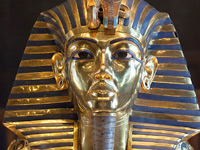
RESOURCES
This article uses material from the Wikipedia article "King Tut (1341-1323 BC)", which is released under the Creative Commons Attribution-Share-Alike License 3.0.
© Stories Preschool. All Rights Reserved.
